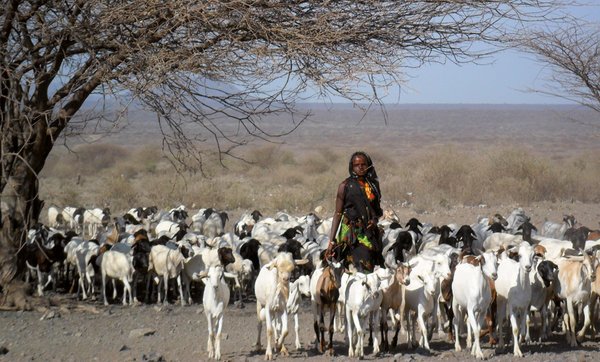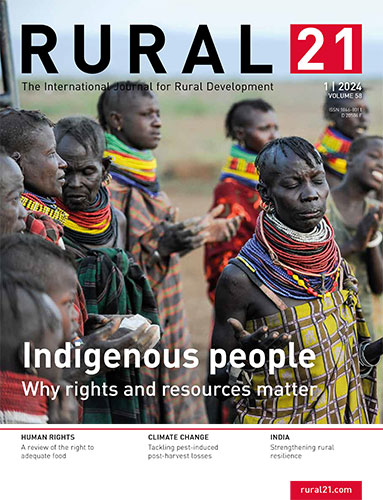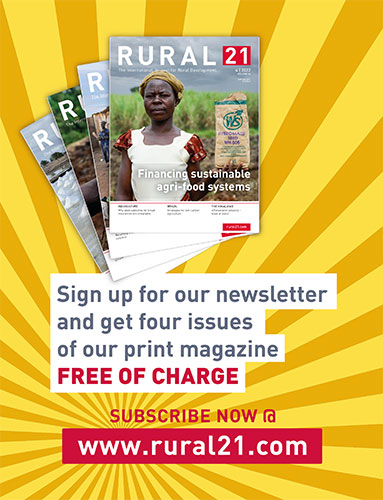 Download this article in magazine layout
Download this article in magazine layout
- Share this article
- Subscribe to our newsletter
Rangelands –sound management strategies for a vulnerable resource
Rangelands cover between 30 and 50 million km2 world-wide, which is two to three times the area used for farming. Rangelands exist on all continents in different agro-ecological zones, and comprise ecosystems as different as natural grasslands, savannas, shrublands, desert fringes, tundras, alpine communities, marshes and meadows. Well-known examples are African savannas, the Australian outback, South America’s cerrados and campos, North American prairies and Central Asian steppes. Here, crop production is usually severely constrained, either by low annual precipitation with high seasonal and inter-annual variability, or by periodically low temperature, with both leading to rather short and often variable vegetation periods and high production risk. In rangelands, soils are covered with indigenous vegetation consisting predominantly of grasses, grass-like plants, forbs, or shrubs. They are managed as natural ecosystems, provide a multitude of important ecosystem services and have a high potential to sequester carbon.
Rangelands are predominantly used for livestock production – about 70 per cent of the African and 25 per cent of the Latin American ruminant livestock population is kept on rangelands – and contribute considerably to the agricultural gross domestic product (GDP) in many developing countries. The main feed resource is the natural vegetation, and rangeland-based livestock systems can operate with no or low levels of concentrate feed produced on agricultural land. Livestock keepers gain their livelihoods by transforming the natural vegetation into valuable products through livestock. Pastoralists and agro-pastoralists most often use communal rangeland resources whereas commercial ranching is usually done on privately owned rangeland.
Rangeland as a social-ecological system
“Range succession”, “state and transition”, “non-equilibrium” or “cusp catastrophe” models have been employed to understand rangeland vegetation dynamics under the influence of different bio-geophysical drivers. However they do not adequately consider that the impact of grazing animals is determined by the livestock keepers’ management and therefore its effect is highly variable in space and time. Shaped by the people who use and manage them, rangeland-based livestock systems are therefore called “social-ecological systems”. Range conditions result from long-term human-animal-environment interactions, and the human users are inherent drivers of the system rather than a disturbance for its inherent ecological properties. This view focuses on dynamics of rangeland systems and on their capacity to tolerate disturbance, i.e. their resilience and adaptive capacity.
Major external threats and internal challenges
Rangelands today are under pressure from numerous competing claims. Globally, population growth triggers food production to expand onto rangelands, and climate change increases variability and the occurrence of extreme weather events, exacerbating uncertainty and risk. Globalisation of markets facilitates access to use rights and concessions for rangelands that can be profitably exploited and speculated with by outsiders.
Operating under communal use of common property with no formalised land titles, the vast majority of today’s rangeland-using communities are particularly vulnerable. Having developed sophisticated rangeland utilisation patterns and shaped the larger ecosystem and the resource distribution in it over millennia, they now face change processes at a pace their own hitherto functioning adaptation strategies are unable to respond to in good time. And they find themselves increasingly marginalised by the economic system and – consequentially – their own governments and societies regard them as standing in the path of progress. Ironically, the evidence of such progress producing negative externalities by far outnumbers the evidence of positive examples of alternative forms of rangeland use. Scientists and decision-makers are still at a loss to unambiguously demonstrate positive effects of projects investing in rangelands (particularly foreign direct investment projects) on social and economic welfare.
Rangeland degradation can mostly be observed around areas with concentrated human population. Sedentarisation was mainly triggered by fixed point delivery of infrastructure and services, or by insecurity in the areas. Additionally, during the past decades, the size of rangeland available to the respective communities has in many cases shrunk considerably due to external claims, often targeting specifically important rangeland patches and thus rendering much larger rangeland stretches unsuitable for profitable livestock production.
Key issues for sustainable rangeland management
Sustainable rangeland management solutions must be ecologically sound with no long-term ill-effects for the natural resource base, economically profitable with no necessity for subsidies and socio-culturally acceptable with respect to chartered and un-chartered access and benefit rights for rangeland-dependent communities and consensual resource allocation. New concepts must be studied, understood, tested, modified and adapted with rangeland users and representatives of governing bodies in trans-disciplinary research approaches to render them suitable in the respective locations. Nevertheless certain key principles for sustainable rangeland management can be generally advocated:
- Livestock mobility is the principal strategy to make use of the high spatio-temporal variability of the vegetation resources which translates into rangeland patches with different vegetation communities. Together with the high inter- and intra-annual rainfall variability, these patches show different forage quantity and quality throughout the year. Therefore, for livestock to be productive, grazing units with an above-average quality and quantity of forage have to be selected at any given point in time (throughout the year) in order to permit the animals the best possible energy and nutrient intake for as long a period as possible during the year. This strategy requires mobility, and moving animals strategically to appropriate forage areas is paramount in guaranteeing that the animals remain productive and the system remains ecologically and economically viable. On large-scale commercial ranches, rotational and deferred grazing systems can mimic this strategy to some extent. Therefore, rangeland users’ knowledge is key to sustainable management.
- Time, timing and location are crucial factors in grazing as plants and plant communities are heterogeneously distributed and differently react to and tolerate animal impact (defoliation, trampling) or disturbance and must be allowed different time-spans for recovery. Plants that are re-grazed too soon and too frequently will continuously lose root-biomass and finally die. Concentrated high impact of grazing animals for short durations on abundant senescent vegetation can remove low quality forage and stimulate high quality regrowth if followed by sufficient rest periods. Palatability has been demonstrated to be a compound property of a diet determined by nutrient content, variety, taste, secondary compounds, sequence of ingestion and post-ingestive experience rather than by taste and/or presence of toxins alone, and animals learn to utilise a larger variety of plants if herded consciously and knowledgably. These findings offer scope for a more even utilisation of available forage and to deliberately induce changes in rangeland vegetation and its quality through herding and animal impact. New management concepts (see Box below) show promising results in both private and common property systems across different ecosystems on different continents.
New concepts in grazing management
In targeted grazing, animals are “grazed” at specific points in time, for specific durations and at specific intensity in a particular area in order to achieve specific vegetation management goals, the focus being on using animals to deliberately improve the vegetation. High-density and ultra-high density grazing, mob-grazing or bunch-grazing are similar strategies, with very high numbers of animals herded or confined by makeshift electric fences on small patches for very short durations, aimed at their eating all the available forage and trampling the residue so that no standing biomass remains.
Plant litter trampled and mixed into the soil with the animals’ urine and faeces will predominantly be decomposed by biotic processes and increase soil organic matter much more than standing litter left to predominantly abiotic decomposition. Circuit grazing considers different nutrient and secondary compound contents of plant species and takes the animals along a grazing circuit that will lead to intake of a variety of different plant species in such a sequence that the satiation threshold will be higher. This means that animals will have higher feed intake and consequently better performance than if they were to feed on the same plant species in a different sequence.
- Different animals prefer different plants and select and compose diets differently. It is therefore important to monitor vegetation and ensure that grazing pressure is exerted to warrant an even utilisation of all vegetation strata. This is best achieved with systems using different livestock species with different feed preferences and integrating wildlife. On communal land, this could be achieved through community-based co-management approaches. On private land, mixed livestock wildlife ranching systems would be an option.
- Institutional and legal mechanisms are important to secure tenure and resource-management arrangements when rangelands are used in a communal way. In some countries, there are efforts to revitalise pastoral customary institutions with their communal regulation of pasture and water management. These aim at overcoming the effects of people and livestock concentrations and the concurrent overexploitation and resource degradation.
- With the increasing interest to invest in rangelands, communities need to re-organise their resource governance system. Bio-cultural Community Protocols (BCPs) are currently being implemented with different pastoral communities, such as the Boran and the Samburu in northern Kenya, as a framework for mainstreaming community rights and securing the hitherto un-chartered customary access to grazing land. This builds on experience gained in South Africa, Ghana, Burkina Faso and Ethiopia, where BCPs were introduced to address issues of access and benefit sharing relating to natural resources. With BCPs, local communities can articulate their governance and stewardship of their localities, affirm their knowledge and strategies for resource use and assert their rights under customary, national and international law.
- As infrastructure in the vast rangelands is usually underdeveloped, integration of rangeland-based livestock systems into the market economy is constrained, especially for pastoral producers. Improving information flows e.g. via mobile phones improves pastoralists’ access to information such as early warning in case of droughts or epidemics. Market integration of pastoral livestock production is an important buffer for increasing climatic variability. Improved access to a combination of financial, insurance and early warning services can offer alternatives to storing capital “on the hoof” and is a precondition for increasing commercial livestock offtake from pastoral systems.
The article has been prepared in the framework of “GrassNet” – a cross-continental research network for sustainable adaptation of grassland systems vulnerable to climate change that is funded by the German Academic Exchange Service (DAAD).
Christian Hülsebusch
Hassan G. Roba
Brigitte Kaufmann
b.kaufmann@ditsl.org
Deutsches Institut für Tropische und Subtropische Landwirtschaft
(DITSL GmbH) Witzenhausen at the University of Kassel
Witzenhausen, Germany





Add a comment
Be the First to Comment